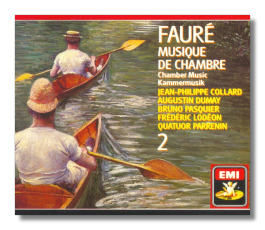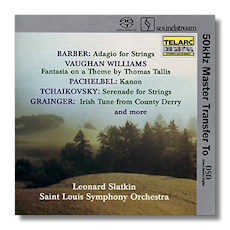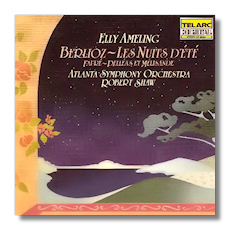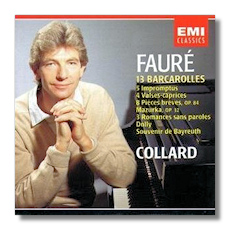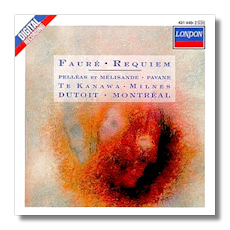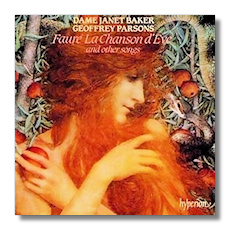
The Internet's Premier Classical Music Source
Related Links
-
Find CDs & Downloads
Amazon - UK - Germany - Canada - France - Japan
ArkivMusic - CD Universe
Find DVDs & Blu-ray
Amazon - UK - Germany - Canada - France - Japan
ArkivMusic-Video Universe
Find Scores & Sheet Music
Sheet Music Plus -
Recommended Links
Site News
Gabriel Fauré
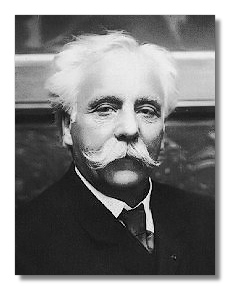
(1845 - 1924)
Gabriel Fauré (May 12, 1845 - November 4, 1924) stands as one of the great French composers of the nineteenth and early twentieth centuries. He single-handedly brought French chamber music to a level where one could reasonably consider it alongside the German tradition. In addition, he is the locus classicus of the French art song, as central to that tradition as Franz Schubert is to German Lieder.
Fauré studied, not at the Paris Conservatoire, but at the Ecole Niedermeyer from 1854 to 1865, where he intended to become an organist and choirmaster. The school, specializing in religious music, set out a curriculum of plainchant, Renaissance polyphony, and organ studies. In addition, the school instruction included a strong literary component. Fauré studied with Niedermeyer himself until the latter's death. He then encountered Camille Saint-Saëns, who had taken the piano class, and who introduced Fauré to contemporary music. Fauré composed his first masterpiece, the Cantique de Jean Racine (1865), while still a student. The piece is remarkable in that it instantly proclaims the composer. Unlike his contemporaries, Fauré avoids standard harmonies, employing instead a modal style, with a leaning toward enharmonic, rather than functional modulations. It's been called a "side-slipping" style and allows Fauré to quickly get to remote keys and back again. Standard modulations tended to lead the listener through a series of logically-linked aural "doors": you can hear where you've come from and where you're going. With Fauré, the effect is more like a Star-Trek teleporter. Suddenly, you find yourself in a new place, far from your point of departure.
On graduation, Fauré held a number of successive church-organist posts. His music at this time is mainly choral church music. During the Franco-Prussian War, he served in an infantry regiment and saw serious action. Upon discharge, he held more church jobs and became involved with Saint-Saëns's circle, including the great opera singer and close friend of Frédéric Chopin, Pauline Viardot (Hector Berlioz and Robert Schumann were fans) and the composers Vincent d'Indy, Eduard Lalo, Henri Duparc, and Emmanuel Chabrier. With them he helped form the Société Nationale de Musique, which was to present many of his premieres.
In 1877, Fauré became engaged to Viardot's daughter Marianne, but she broke it off. He started to suffer from bouts of depression, which lasted most of his life. Around this time, he wrote some of his finest chamber music, including the first piano quartet and the first violin sonata. He began to travel, met Franz Liszt, and mainly saw and heard a lot of Richard Wagner – the Ring, Tannhäuser, Meistersinger, Lohengrin, and Tristan – but without turning into the Perfect Wagnerite. His music remains, unlike that of so many of his contemporaries and even his teacher Saint-Saëns, resolutely French. He also began composition on his most famous work, the Requiem, and tinkered with it for the next twenty-plus years. It appeared in three main versions: the original of 1877 for choir and organ; for choir and small orchestra, completed in 1893; for choir and full orchestra in 1900. The Seventies and the Eighties saw the appearance of songs and pieces for solo piano. Fauré also attempted large-scale orchestral works – notably a symphony and a violin concerto – but either withdrew them or left them incomplete. Although he did write for orchestra, mainly incidental music and suites, his true interests lay elsewhere.
Fauré married in 1883. The marriage was a difficult one, and Fauré frequently carried on affairs, including one with Emma Bardac who was to become Debussy's second wife. Money was a problem. He had to support himself by giving private lessons and with his church posts. His songs brought him practically nothing; his publisher bought them outright for a few francs apiece. For most of his life, he had the time to compose only during summer holidays. His only opera, Pénélope, cost him five summers.
Recognition came to Fauré in the 1890s. He began to move in high society and numbered among his acquaintences John Singer Sargent, Frank Schuster (also a friend of Elgar), the Princess de Polignac, and Proust, who drew his descriptions of Vinteuil's music from Fauré's works. However, he was prized as much, if not more, for his personality than for his music, which most considered too esoteric and difficult. The sense of tonality loosened as he grew older. Indeed, one can find both whole-tone passages, independent of Claude Debussy, and stretches of harmonic no-man's land, without ever becoming atonal. In 1896, he became a composition professor at the Paris Conservatoire, succeeding Jules Massenet, and his pupils included Maurice Ravel, Koechlin, Schmitt, Nadia Boulanger, and George Enescu. In 1905, he became the director of the Conservatoire. This, more than anything else, got his music played. In 1909, he was elected to the Institut. His financial worries lessened, although he never got rich.
He also discovered that he was growing deaf, although this didn't stop him from composing. Indeed, his late period is rife with wonderful work, mostly chamber pieces and songs. He retired from the Conservatoire in 1920 and began composition full-time, resulting in more masterpieces – the second cello sonata and piano quintet, the piano trio, and the cycle L'horizon chimérique.
Fauré lived a long life. He was in his twenties when Berlioz died, and he himself outlived Debussy by six years. His music has never been cursed by fashion. Although among the general public he seems almost an afterthought in French music, he always had his admirers, even among the young Turks (Aaron Copland, Francis Poulenc, and Ravel adored his work). The late music especially is filled with an individual mixture of uneasiness and incredible serenity. His melodies, although avoiding dramatic extremes, in effect lead you down a rabbit-hole of one beautiful surprise after another. ~ Steve Schwartz

Recommended Recordings
 Chamber Music with Piano (
Chamber Music with Piano ( Quartets &
Quartets &  Quintets)
Quintets)
- Piano Quartets #1 Op. 15 & #2 Op. 45 and Piano Quintets #1 Op. 89 & #2 Op. 115/EMI CMS7625482
-
Jean-Philippe Collard (piano)/Quatuor Parrenin
- Piano Quartets #1 Op. 15 & #2 Op. 45 and Piano Quintets #1 Op. 89 & #2 Op. 115/Vox Music Group CDX5073
-
Jacqueline Eymar (piano), Günter Kehr & Werner Heuhaus (violins), Erich Sichermann (viola), Bernard Braunholz (cello)
- Piano Quartets #1 Op. 15 & #2 Op. 45/Hyperion CDA66166
-
Domus
Pavane
- Pavane, Op. 50; Pelléas et Mélisande suite; Requiem/London 421440-2
-
Charles Dutoit/Montréal Symphony Orchestra
- Pavane, Op. 50 w/ Vaughan Williams, Barber, Grainger, Pachelbel, Satie & Tchaikovsky/Telarc CD-80059 or SACD-60059
-
Leonard Slatkin/Saint Louis Symphony Orchestra
Amazon - UK - Germany - Canada - France - Japan
or Hybrid SACD
Amazon - UK - Germany - Canada - France - Japan
Pelléas et Mélisande
- Suite "Pelléas et Mélisande", Op. 80; Pavane; Requiem/London 421440-2
-
Charles Dutoit/Montréal Symphony Orchestra
- Suite "Pelléas et Mélisande", Op. 80 w/ Berlioz/Telarc CD-80084
-
Robert Shaw/Atlanta Symphony Orchestra
Piano Music (Barcarolles & Nocturnes)
- Barcarolles (complete)/EMI CDC7473582
-
Jean-Philippe Collard (piano)
- Nocturnes (complete), Preludes (complete), Ballade/EMI CMS7691492
-
Jean-Philippe Collard (piano)
- Preludes (complete), Impromptus (complete) and Theme & Variations/CRD 3423
-
Paul Crossley (piano)
Requiem
- "Messe de Requiem", Op. 48/Telarc CD-80135
-
Judith Blegen (soprano), James Morris (bass), Robert Shaw/Atlanta Symphony Orchestra
- "Messe de Requiem", Op. 48; Pelléas et Mélisande suite; Requiem/London 421440-2
-
Kiri Te Kanawa (soprano) Sherill Milnes (bass), Charles Dutoit/Montréal Symphony Orchestra
- "Messe de Requiem", Op. 48/Harmonia Mundi HMX2901413.15
-
Mellon (soprano), Kooy (bass), Philippe Herreweghe/La Chapelle Royale Orchestra, La Chapelle Royale Choir, Les Petits Chanteurs de Saint-Louis & Ensemble Musique Oblique
Songs
- 18 Songs/Hyperion CDA66320
-
Dame Janet Baker (mezzo-soprano), Geoffrey Parsons (piano)
- Songs (complete)/EMI CDM7640792
-
Elly Ameling (soprano), Gérard Souzay (baritone), Dalton Baldwin (piano)














